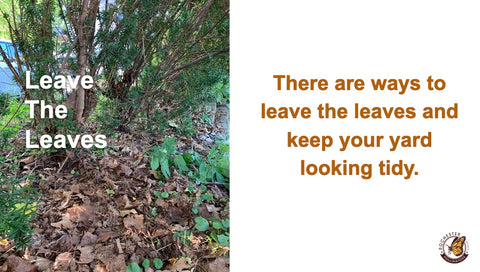Pollinators Have Something to Say About Leaves. . .

It is now mid-October and colder temperatures and shorter days bring beautiful fall colors. Enjoy them while you can, Autumn isn't called "Fall" for nothing! Soon these bright and earthy colors cascade to the ground, leaving tree branches barren until spring.
Children love to pile the leaves and jump in them, but for many adults the leafy carpet means a lot of work on the weekends to clear and manage the fallen leaves. Raking and bagging and hauling the bags to the curb . . . What if we told you that you don't have to work that hard? Instead you could spend some of those hours biking to the nearest cider mill with your family for some hot donuts and local cider!
While many of us humans who live in suburban and urban communities value a tidy lawn, pollinators would prefer it if you didn't do anything with your leaves! They need them for food and for overwintering as eggs, larva and adults.

Some examples of butterflies who are dependent on leaf litter and dead plant stalks and pods to survive the winter are pictured below and mentioned in order, clockwise from upper left:
- The Tiger Swallowtail, Eastern Swallowtail larvae form a chrysalis in fall that is attached to leaves and dead plant stalks. The butterfly will emerge in the spring if it left undisturbed.
- The Red-banded Hairstreak, lays its eggs in oak and other hardwood leaf litter and then hatches in spring.
- The Question Mark butterfly hibernates in leaf litter as an adult.
- The Eastern-tailed Blue larvae mature in fall and crawl into an empty seed pod until spring when it will pupate and emerge as an adult butterfly.
- The larvae of the Tawny Emperor and the Great Spangled Fritillary shelter in fallen leaves until spring.

These are just a few of the many pollinators that need shelter in leaf litter or dead garden vegetation for the winter. Many of our native bees also need fallen-leaf shelter in winter to keep doing the good pollinator work that we all depend upon.
Right about now you might be thinking:
Sure, I care about the pollinators, but what about my lawn?? What about my neighbors??
There are 40 million acres of lawn in the United State which makes turf grass the largest single crop that grows. To mimic the natural habitat a pollinator needs, a layer of leaves needs to be at least a couple of inches thick. While this would be too much of a good thing for turf grass to handle, there are some other things you can do to help.

Research has shown that lawns actually benefit from a thin layer of leaves. You can mow some of them along with your grass and the rest can be piled up as whole leaves around trees, shrubs, and perennials to no ill effect. Leaving some of the leaves whole is important because you retain pollinator habitat that way.
The leaves you place around the trees and layer in your garden beds act as mulch. They not only shelter pollinators, but offer insulation and nutrients for your perennials. Fallen leaves have the same weed suppression and moisture retention properties of shredded wood mulch and they're free!
A recent article in USA Today (10/15/21), Good news: You don't need to rake your leaves. Experts explain why, states that "raking and removing leaves can be worse for your yard – and for the planet." In addition to providing necessary habitat for pollinators and other living things, and free fertilizer for your garden, experts weigh in with these facts:
- the leaves return valuable nutrients to the soil that they took out of it as they grew, which reduces or eliminates the need for outside fertilizer
- they suppress weeds
- when bagged leaves and other yard waste is taken to the landfill, more methane is created as this concentrated organic material slowly breaks down; methane is a greenhouse gas that contributes to global climate change
If you still feel you must keep your lawn clear of leaves, consider raking whole leaves up and creating a leaf pile in a back corner of your yard or behind your garage. Then allow it to break down slowly and naturally. If you have a compost area, you can stir many of the leaves into it to retain the nutrients on the land that generated them. In spring you can fold some of this into your garden soil to feed your plantings.
Leaving all the leaves on your lawn might not work for you, but these modifications in your fall clean-up will keep our pollinating critters safe and allow you to benefit from the rich garden gift that falls from the trees above.
Hopefully you will still get out there to the cider mill this fall! And while you enjoy your delicious treat, thank the pollinators for the apples that grew on the trees this summer!

For more information on this topic try:
Leave the Leaves to Benefit Wildlife by Scott Hoffman Black of the Xerces SocietyFall Garden Tips to Benefit Bumblebees All Year by Michele Blackburn and Rich Hatfield
And more resources available on our Rochester Pollinator Website here:
Saving Pollinators in Fall and Spring
